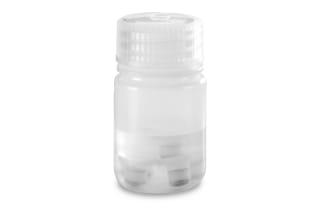
|
Chemistry |
Anion-Exchange |
|
Separation Mode |
Ion-Exchange |
|
Maximum Pressure |
1000 psi (70 Bar) |
|
Particle Shape |
Spherical |
|
Format |
Concentrator Insert |
|
System |
HPLC |
|
UNSPSC |
41115709 |
|
Brand |
IC-Pak |
|
Product Type |
Accessories |
|
Units per Package |
5 pk |

IC-Pak Anion Concentrator Inserts, 5/pk
Waters provides a variety of ion chromatography-related products. You can examine a broad spectrum of ions from numerous sample matrices, both simple and complicated, using IC-Pak resin-based columns. They provide an outstanding linear loading range without dilution and without limiting the pH of the eluent or the sample, ranging from less than 1.0 ppb to more than 400 ppm. At all concentration levels, there is flexibility for precise and repeatable anion and cation studies.
Liquid chromatography columns have a limited lifespan that is strongly correlated with how well they are maintained and used. Contamination from samples and solvents, frequent solvent changes, inappropriate handling, and inadequate storage can shorten column life. Take quick action to ascertain the cause of any changes in peak form, retention of a specific chemical, or resolution between two compounds. Do not depend on the conclusions of the analyses until the cause has been identified.
In order to provide you the assurance that the lab equipment will not need to be replaced frequently and will give you reliable findings, Waters assures that only the highest quality standards and harshest conditions are employed in its manufacturing. The cGMP, ISO9001, and ISO13485 certified specialized Waters facilities, where each stage of the manufacturing process is meticulously controlled, and the strictest conditions are guaranteed, are where the IC-Pak Cation Column is produced. This makes it possible to produce the IC-Pak Cation Column with the strictest market criteria, ensuring reliable results each and every time.
You will be able to directly shop for lab equipment from our website and also have the option of getting in touch with a member of our global staff to assist you with any queries, concerns, or general guidance regarding lab equipment as needed.
You might also be interested in Waters LCMS Certified Clear Glass 12 x 32 mm Screw Neck Vial, with Cap and Preslit PTFE/Silicone Septum, 2 mL Volume, 100/pk; all Waters LCMS Certified vials are produced following tightly controlled manufacturing processes and handling procedures. They are rigorously tested with mass spectrometers and come packaged with a certificate of analysis showing the reference and vial scan for the manufacturing lot.
How Should I Approach Filtration?
Before inserting the sample, add around 1 mL of air to the syringe. This will enable the sample to be removed from the syringe together with air. The amount of fluid retained inside the filter device is decreased by this "air purge." The filtered solution should then be poured into the syringe. Twist the loaded syringe to the filter device while holding the filter device in one hand (without using too much force). Start filtering by exerting light pressure.